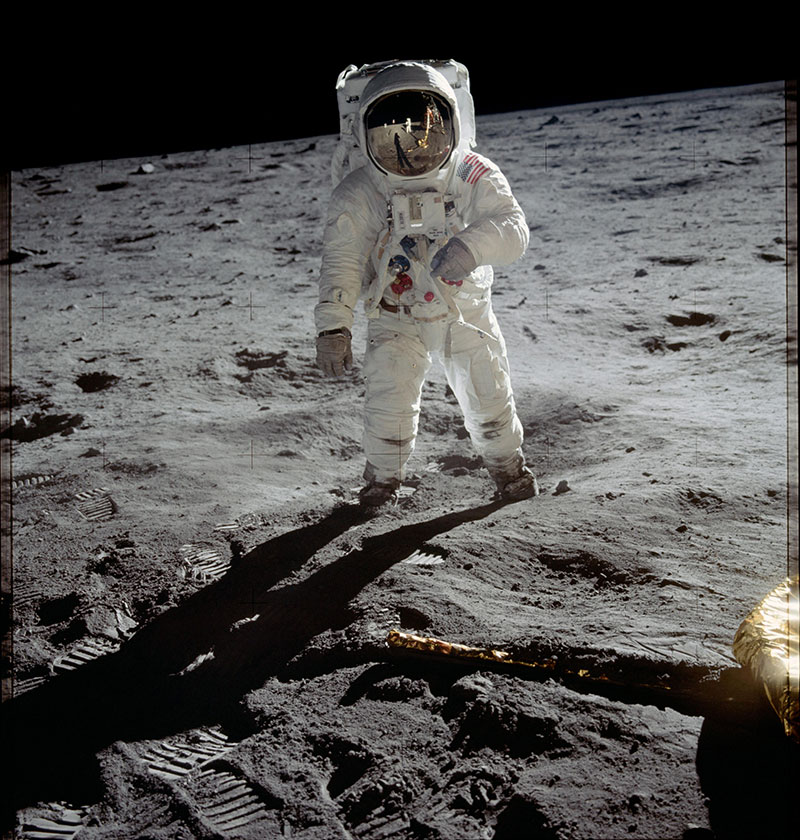

Earth Data
- Average distance from the Sun: 150 million km
- Orbital period: 1 year
- Diameter: 1.00 x Earth diameter (12,756 km)
- Mass: 1.00 x Earth mass (6 x 1024 kg)
- Rotation period: 24 hours
- Average density: 5.52 g/cm3
- Composition: rocky (including both rock and metal)
- Average surface temperature: 15°C
- Moons: 1
Moon Data
- Average distance from Earth: 384,000 km
- Orbital period around Earth: 27.3 days
- Lunar cycle period (new moon to new moon): 29.5 days
- Diameter: 0.27 x Earth diameter
- Mass: 0.012 x Earth mass
- Rotation period: 27.3 days
- Average density: 3.34 g/cm3
- Composition: rocky
- Average surface temperature: 125°C (day), –175°C (night)
Beyond Venus and only about 15 meters from the model Sun, we find our home planet. Its tiny size in a big solar system reminds us that Earth is a rare and precious oasis of life. It is the only planet with oxygen for us to breathe and ozone to shield us from deadly solar radiation. Only on Earth does water flow freely to nurture life. And temperatures are ideal for life because Earth’s atmosphere contains just enough carbon dioxide and water vapor to maintain a moderate greenhouse effect.
Despite its small size, Earth is striking in it beauty. Blue oceans cover nearly three-fourths of the surface, broken by the continental land masses and scattered islands. The polar caps are white with snow and ice, and white clouds are scattered above the surface. At night, the glow of artificial lights clearly reveals the presence of an intelligent civilization.
Earth is the first planet on our tour with a moon. On our model scale, the Moon is barely visible speck that orbits the Earth at a distance of about 4 centimeters. Thus, your thumb could easily cover both the Earth and the Moon. The Moon is cratered and desolate, much like Mercury, though it has its own interesting history and geology. It is also the only world besides Earth on which humans have ever stepped. From July 1969 through December 1972, NASA’s Apollo program successfully landed 12 people (six crews of two) on the lunar surface.
Angular size activity (for those on an actual tour of a Voyage model): Again hold up your thumb at arm’s length and compare it to the size of the model Sun as it appears from the model Earth’s location. Do you notice the change in the Sun’s angular size compared to what it was from Mercury and Venus?
Note 1: If you were to look up at the real Sun in the sky (don’t do this unless you have a pair of eclipse glasses to wear), you’d notice that the real Sun and the model Sun have exactly the same angular size as seen from the model Earth. This shows that the Voyage model is correctly to scale.
Note 2: Take a look at the tiny Moon in the Voyage crystal. You’ll notice that it is located about 4 centimeters (about 1½ inches) from Earth. If you now put one eye (with the other closed) about the same 4 centimeters away from the tiny Moon, it will be about the same angular size as the Sun. This fact — that the Moon and Sun both have about the same angular size as viewed from Earth — explains why the Moon is able to block the Sun during a solar eclipse.
Greenhouse effect activity (for those on an actual tour of a Voyage model): Recall from the information posted at Venus that Venus has an incredibly high surface temperature of about 470°C (880°F). In contrast, Earth has a very comfortable global average surface temperature of about 15°C (59°F). Why is Venus so hot? You might at first guess that Venus’s high temperature is due to it being closer to the Sun, but try this. Imagine that there is a big bonfire at the location of the Sun. Walk back to Venus, then back to Earth, and try to imagine how much of a difference you’d feel in the heat from the bonfire. It will probably be obvious that Venus is not enough closer to the Sun to explain its high temperature (a fact that can be confirmed through calculations). So what is the real reason why Venus is so hot? The answer is what scientists call the greenhouse effect, in which gases like carbon dioxide make a planet hotter than it would be otherwise. Venus has a thick carbon dioxide atmosphere that gives it a very strong greenhouse effect, and that is the reason for its extreme temperature. Earth has far less carbon dioxide in its atmosphere (about 1/200,000 as much as Venus!), which means a much weaker greenhouse effect. Still, without this greenhouse effect (which on Earth involves both carbon dioxide and water vapor), Earth would be frozen at its distance from the Sun. So the greenhouse effect is a very good thing since we would not be here without it – but Venus is proof that it is possible to have too much of a good thing, and the reason scientists are concerned about global warming is because human activity (especially the burning of fossil fuels) is adding more carbon dioxide (and other greenhouse gases) to the atmosphere, thereby strengthening Earth’s greenhouse effect.

The dot at the top of the page (next to title) shows Earth’s size on the scale. Note: Because the scale is the same for all Voyage models (found in communities across the country), you can use this same tour with any of them.